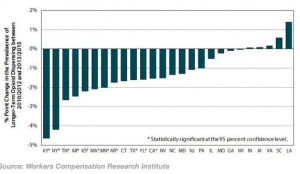Today’s WorkCompCentral arrived with William Rabb’s report on the use of opioids by workers’ comp patients in Louisiana. [subscription required]
A few notable findings:
- Louisiana work comp patients get more opioids, and they get them for longer periods of time than any other state studied
- Employers and taxpayers pay significantly higher prices for drugs than in other states
- 7 out of 10 claims included an opioid prescription
- Louisiana patients get twice as many opioid scripts than the average state.
For some reason, some “claimant attorneys” don’t see the wisdom of formularies/guidelines intended to reduce inappropriate opioid use, citing spurious claims from the pain industry in attempt to validate their complaints.
Louisiana has had treatment guidelines in place for several years, however they have not been revised or updated in memory and are very difficult to enforce. Compared to other states, the Pelican State has made little progress reducing inappropriate opioid use by work comp patients.

Back in 2017 I cited Sheral Kellar, Director of Louisiana’s Office of Workers’ Compensation Administration discussing the opioid issue in her state.
Ms Kellar knows a formulary is NOT a panacea, rather a critical tool in the armamentarium which includes:
- Prescription drug monitoring programs that require and facilitate pharmacist and physician participation,
- Strong and well-designed utilization review programs,
- Flexibility for PBMs and payers to customize medication therapy to ensure patients get ready access to appropriate drugs and reduce risks from inappropriate medications,
- Carefully-planned implementation,
- Drug testing, opioid agreements, and addiction/dependency treatment
Over the last decade I have spoken with many individuals heavily involved in Louisiana workers’ comp; each frustrated and saddened by the lack of meaningful progress in attacking the overuse of opioids by workers’ comp patients.
What does this mean for you?
Here’s hoping Louisiana is able to make real progress on reducing opioid usage. Families, communities, employers, and providers have all waited long enough.


